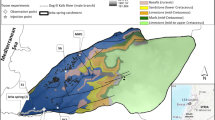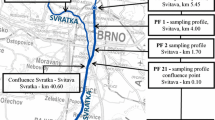Abstract
Fluorescent dye tracer breakthrough curves (TBCs) obtained from quantitative traces in karst flow systems record multiple processes, including advection, dispersion, diffusion, mixing, adsorption, and chemical reaction. In this study, TBCs were recorded from small, bench-scale physical models in an attempt to isolate, understand, and quantify some of these processes under full-pipe flow conditions. Dye traces were conducted through a suite of geometries constructed out of Pyrex glass. These geometries consisted of (1) linear conduits, of varying length and diameter, (2) single and dual mixing chambers, and (3) a single chamber with an immobile region. Each glass system was connected to a constant flow apparatus. Dye was then injected with a syringe, allowed to flow through the system, and be naturally or artificially mixed in the process. Solute breakthrough was recorded in a scanning spectrofluorophotometer and the resulting TBC was analyzed. Independent variables examined in each of the three settings were discharge (Q) and dye concentration (C o). Artificial mixing rates (R M), induced by magnetic stirrers in settings (2) and (3), were also considered. Initial runs varied Q from 0.75 to 1.25 mL/s, with constant R M ranging from 0 to 360 revolutions per minute (rpm). Preliminary data yield realistic-looking breakthrough curves with steeply rising leading edges, a peak, and an asymmetric, exponential tail. Analysis of laboratory variables with respect to hydraulic parameters extracted from each TBC suggests that discharge and mixing rate alone can differentiate conduit complexity at the laboratory scale.






Similar content being viewed by others
References
Anger CT (2010) Laboratory and numerical modeling of bench-scale dye breakthrough curves: M.S. Thesis, University of Minnesota, Department of Geology and Geophysics, p 91
Birk S, Geyer T, Liedl R, Sauter M (2005) Process-based interpretation of tracer tests in carbonate aquifers. Ground Water 43(3):381–388
Field MS (1999) The QTRACER program for tracer-breakthrough curve analysis for karst and fractured-rock aquifers: US Environmental Protection Agency, report number EPA/600/R-98/156A, p 194
Field MS, Pinsky PF (2000) A two-region nonequilibrium model for solute transport in solution conduits in karstic aquifers. J Contam Hydrol 44(3–4):329–351
Geyer T, Birk S, Licha T, Leidl R, Sauter M (2007) Multitracer test approach to characterize reactive transport in karst aquifers. Ground Water 45(1):36–45
Hauns M, Jeannin PY, Atteia O (2001) Dispersion, retardation and scale effect in tracer breakthrough curves in karst conduits. J Hydrol 241(3–4):177–193
Morales T (2007) Predicting travel times and transport characterization in karst conduits by analyzing tracer-breakthrough curves. J Hydrol 334(1–2):183–198
Moreno L, Tsang CF (1991) Multiple-peak response to tracer injection tests in single fractures—a numerical study. Water Resour Res 27(8):2143–2150
Smart CC (1988) Artificial tracer techniques for the determination of the structure of conduit aquifers. Ground Water 26(4):445–453
White WB (1988) Geomorphology and hydrology of karst terrains, Oxford University Press, New York, p 464
Author information
Authors and Affiliations
Corresponding author
Rights and permissions
About this article
Cite this article
Anger, C.T., Alexander, E.C. Bench-scale models of dye breakthrough curves. Carbonates Evaporites 28, 221–227 (2013). https://doi.org/10.1007/s13146-012-0092-7
Accepted:
Published:
Issue Date:
DOI: https://doi.org/10.1007/s13146-012-0092-7




